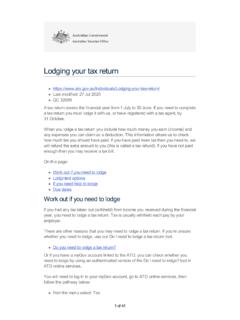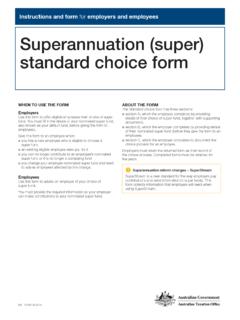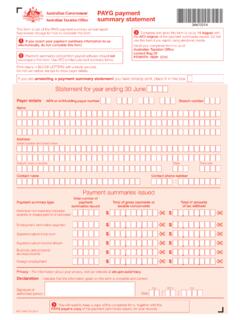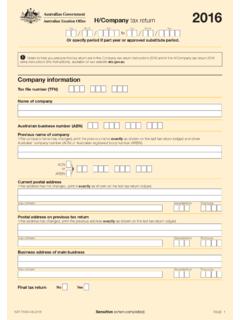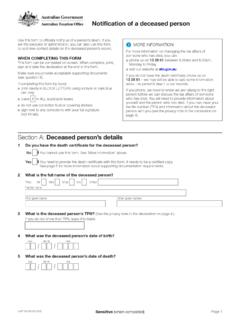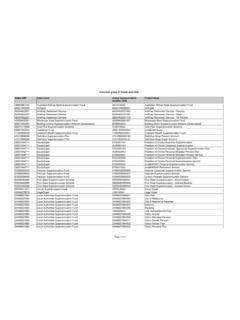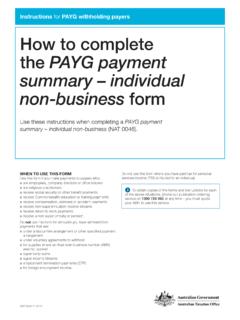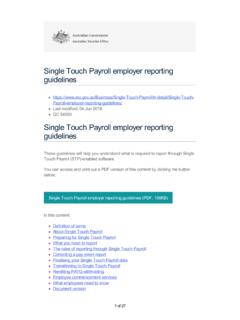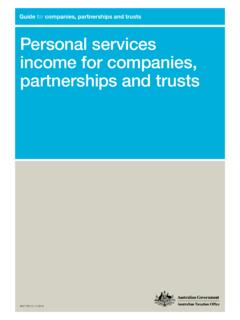Transcription of Helping you understand your GST obligations
1 Introduction for small businessGSTH elping you understand your GST obligationsGETTING STARTEDWhat is GST?The goods and services tax (GST) is a tax of 10% on most goods and services sold in you run a business, you are likely to have some gst obligations . GST 1If your business is registered for GST, you need to: n include GST in the price of sales to your customersn claim credits for the GST included in the price of your purchases for your business. This means, if your business is registered for the GST, your customers pay the cost you charge plus 10% extra. This 10% is the GST. When GST applies, you should always include GST in the price of your then send these 10% GST amounts to the Australian Taxation Office (ATO), usually four times each year.
2 To do this, you fill in and send the ATO a form called a business activity statement (BAS), which the ATO will send you. You can also claim GST credits on the runs a small bakery selling sandwiches, cakes, hot foods and drinks. She charges her customers an extra 10% to cover the GST. For example, she sells salad sandwiches for $ including GST. She keeps $5 and sends the GST amount of 50 cents to the ATO when she fills in her next BAS. 2 GSTR egistering for GST Do you have to register your business for GST?You must register for GST if any of the following apply:n you are in business and your annual business income is $75,000 or more a year (or you think it will be) or $150,000 or more for non-profit organisationsn you provide taxi travel as part of your business.
3 Taxi travel means transporting passengers by taxi or limousine for faresn you want to claim fuel tax your annual business income is less than $75,000 (or $150,000 for non-profit organisations), you don t have to register for GST but you can choose to register. Registering for GST means you can claim back the GST you pay on goods and services you buy for your business but only if you have a tax invoice from your s bakery sells a variety of pre-packaged drinks, including soft drinks and flavoured milks such as chocolate three months, Anh purchases 200 pre-packaged chocolate milks from her supplier for $110 including GST.
4 She receives the invoice from her supplier and she pays the supplier $ Anh s business is registered for GST, she can claim $10 as GST credit from the ATO. Anh needs to keep her tax invoice to do this. GST 3 Taxable and GST-free itemsIs GST included in the price of everything you sell?If you are registered (or required to be registered) for GST purposes, GST is included in the price of most goods and services you sell to others in the course of your business. These are called taxable sales . There are some goods and services which are GST-free , meaning you don t have to charge your customer GST. But you can still claim GST credits.
5 These GST-free items include:n most basic food n some education courses, course materials and related excursions n some medical, health and care services n some medical aids n some medicines n some goods produced for export n some childcare n some religious services and charitable activities. 4 GSTE xampleNot everything Anh sells in her bakery will attract GST. Here are some examples of basic food she sells that is GST-free (no GST is charged):n bread and bread rolls without icingn bottled drinking water n fruit juice containing at least 90% by volume of juicen are some examples of food she sells that does have GST ( taxable sales ):n sandwichesn cakes, slices, pastries, pies and sausage rollsn soft drinks and flavoured milk n platters of prepared Anh is not sure, she checks the ATO s English publication GST food guide (NAT 3338).
6 GST 5 Reporting GST amounts and claiming GST creditsWhat to do with the GST amounts you collect Businesses use the BAS to let the ATO know how much they have earned, the amount of GST collected and the GST they paid for goods and services. When you get your BAS, fill it out, send it to the ATO and pay any money you owe by the due date. The due date is written on the BAS. TIP Keep the GST you ve collected separate to your earnings. If you keep the GST in a different bank account, it is ready to be paid to the ATO when it is due. How to claim back the GST you pay to suppliers (GST credits)As GST is paid by the consumer, not businesses, you can claim back any GST you have paid for things that you have bought for your business.
7 To claim a GST credit for a purchase that cost more than $ (including GST) you must be registered for GST and have a valid tax invoice that records what you have purchased for your business. In most cases, the business or supplier selling the goods or services issues the tax invoice. When you receive this invoice, make sure that it contains the following information: n the supplier s business or trading namen the supplier s Australian business number (ABN)n the date of the tax invoice6 GSTn a brief description of the items sold including the quantity and the price it was sold atn the GST amount (or a statement which says The total price includes GST )n your business name or ABN (if the taxable sale is $1,000 or more)n that the document is intended to be a tax claim a GST credit for a purchase that cost $ or less (including GST)
8 , you must be registered for GST and you must keep documents such as cash register dockets, receipts or invoices to support your must also keep your tax invoices and other GST records for five years. TIP Even if you sell GST-free items, such as plain breads and bread rolls, you can claim GST credits for the GST included in the price of things that you buy to produce the items, for example, baking trays, measuring cups and mixing else can you claim?If you use fuels in your business and meet certain conditions you can claim fuel tax credits. For example, you may be able to claim fuel tax credits for fuel used in machinery or equipment, or for petrol used in vehicles with a gross vehicle mass (GVM) greater than tonne.
9 What you can claim depends on the type of fuel and how it was used. These credits will give you back some of the money you paid for your fuel. For more information on fuel tax credits, go to GST 7 Tax invoices Do you need to give a tax invoice to customers?If a customer or client asks you for a tax invoice, you must provide this within 28 days of the day they ask you for it. You must be registered for GST to issue a tax invoice. ExampleAnh s bakery is getting a lot of catering orders lately. She knows that sandwich, cake and fruit platters are all subjected to GST. She prepares a tax invoice for her clients and clearly states the GST that she has charged.
10 She sends the tax invoice along with their order so she doesn t forget to do it GSTG etting helpFree assistance visitsTo help make it as easy as possible for you to comply with your tax obligations , the ATO can arrange an assistance visit. Visits are confidential and conducted by tax officers at your place of business or preferred location. A tax officer can work through any issues you may have and discuss specific tax information of interest to you. A visit can take any time between half an hour to a full day it all depends on what you need. Any information you share with us during a visit will not be told to anyone else, not even other people in the ATO.
